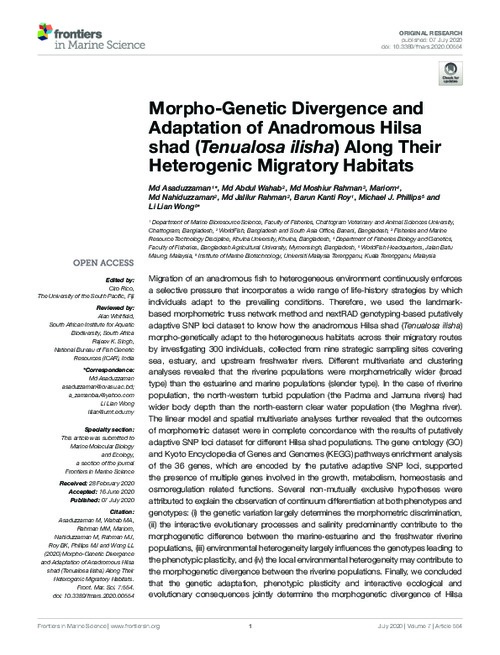Morpho-Genetic Divergence and Adaptation of Anadromous Hilsa shad (Tenualosa ilisha) Along Their Heterogenic Migratory Habitats

Citation
Md Asaduzzaman, et al. (2020). Morpho-Genetic Divergence and Adaptation of Anadromous Hilsa shad (Tenualosa ilisha) Along Their Heterogenic Migratory Habitats. Frontiers in Marine Science, 7: 554.
Migration of an anadromous fish to heterogeneous environment continuously enforces a selective pressure that incorporates a wide range of life-history strategies by which individuals adapt to the prevailing conditions. Therefore, we used the landmark-based morphometric truss network method and nextRAD genotyping-based putatively adaptive SNP loci dataset to know how the anadromous Hilsa shad (Tenualosa ilisha) morpho-genetically adapt to the heterogeneous habitats across their migratory routes by investigating 300 individuals, collected from nine strategic sampling sites covering sea, estuary, and upstream freshwater rivers. Different multivariate and clustering analyses revealed that the riverine populations were morphometrically wider (broad type) than the estuarine and marine populations (slender type). In the case of riverine population, the north-western turbid population (the Padma and Jamuna rivers) had wider body depth than the north-eastern clear water population (the Meghna river). The linear model and spatial multivariate analyses further revealed that the outcomes of morphometric dataset were in complete concordance with the results of putatively adaptive SNP loci dataset for different Hilsa shad populations. The gene ontology (GO) and Kyoto Encyclopedia of Genes and Genomes (KEGG) pathways enrichment analysis of the 36 genes, which are encoded by the putative adaptive SNP loci, supported the presence of multiple genes involved in the growth, metabolism, homeostasis and osmoregulation related functions. Several non-mutually exclusive hypotheses were attributed to explain the observation of continuum differentiation at both phenotypes and genotypes: (i) the genetic variation largely determines the morphometric discrimination, (ii) the interactive evolutionary processes and salinity predominantly contribute to the morphogenetic difference between the marine-estuarine and the freshwater riverine populations, (iii) environmental heterogeneity largely influences the genotypes leading to the phenotypic plasticity, and (iv) the local environmental heterogeneity may contribute to the morphogenetic divergence between the riverine populations. Finally, we concluded that the genetic adaptation, phenotypic plasticity and interactive ecological and evolutionary consequences jointly determine the morphogenetic divergence of Hilsa shad. The interaction of all of these forces and their relative strength in heterogeneous environments, however, made it rather challenging to determine the most probable selective pressure, which has shaped the Hilsa shad morphogenetic divergence across their diverse migratory habitats.
Permalink
Date Available
Type
Publisher
Countries
ISSN
2296-7745
Copyright
CC-BY-NC-4.0
Research Themes
Language